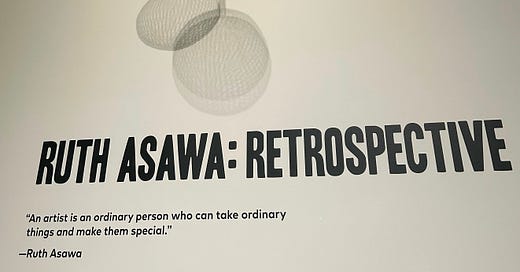One of my favorite parts of the epic and epically inspiring Ruth Asawa Retrospective up at SFMOMA right now was a caption for a painting of an eggplant. In it was a recollection from Asawa’s granddaughters, Lilli Lanier, who who grew up close to her grandmother in San Francisco. “‘Come over tomorrow,’” Lanier remembered Asawa saying. “‘We’re going to draw eggplants. And then we’re going to eat them.’ We’d draw food . . . and then [it would turn] into a cooking lesson.”
The story exemplified Asawa’s organic meld of the ordinary and the everyday with her prolific artistry. It also echoed my first impression of Asawa, who I was exceedingly fortunate to have met as a second-grader. Asawa was either working on a public sculpture or holding some sort of arts workshop, I’m not really sure. She was doing a tremendous amount of arts advocacy in public schools throughout San Francisco during the 1970s. Fortunately that programming eventually reached the Pajaro Valley School Distric. I recall that me and Darius England, two of the more arty kids in our grade, were selected by our teachers to join a busload of other schoolchildren from the district to make art with Asawa.
It was a big deal to take such a special field trip, though I’m not sure exactly where we went that day. I know the bus carried us over Highway 17. It took a while to get wherever there was. And I was surprised to arrive and find an ordinary-looking, unfussy woman running the show. A news crew even showed up to capture some of the proceedings. Asawa took it all in stride: she wasn’t wearing makeup; instead, she was wearing an apron and her hands were covered in dough. She patiently went from table to table, giving we kids tips on how to work with the dough. It was all about the work. And the work — rolling the dough into small logs and shaping it into figures — was, I thought in my kid’s mind, kind of simple. I wasn't so impressed that day, I remember, though everything about that day made a long-lasting impression that has deepened over time.
Especially the more I’ve learned about her story: how Asawa and her family were placed in internment camps during World War II. How she didn’t let racism or sexism stop her from getting an education and went on to be an acclaimed and influential artist. The baker’s clay sculptures represented just a fraction of the sculpture, drawings, prints and more that she created during her life. Prolific, generous with her time, connected to her community, dedicated to arts education while pursuing her own vision, and all while raising a large family?!
The exhibit devoted a large room to a recreation of her living room, where she made work while raising six children (often enlisting them to contribute to her projects) with her architect husband. Asawa was a master of doing her work wherever she was, making the ordinary extraordinary.
I knew most of this before going to the show. Still the exhibit was a wonderful immersion into her amazing life and work. I hope you’ll be able to see it. It rekindled my hope and gave me a shot of inspiration, not just to keep on being creative, but also to be a decent person.
Plus there’s this book, which I may need to read:




